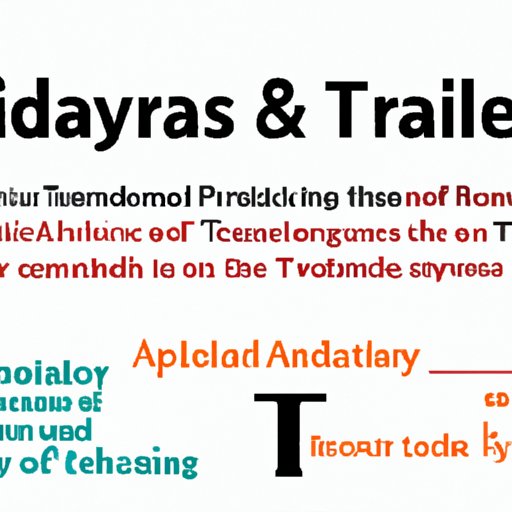
I. Introduction
Text dependent analysis is a vital tool for improving reading comprehension, but many people are unfamiliar with the concept. This article aims to demystify text dependent analysis by providing a comprehensive overview of its definition, purpose, and implementation. The following sections will delve into the importance of text dependent analysis, how it works, and its benefits for students and teachers alike.

II. Unlocking the Power of Text: An Introduction to Text Dependent Analysis
Text dependent analysis involves analyzing text in a detailed and comprehensive manner that focuses on the text’s meaning. This type of analysis identifies and analyzes literary elements such as plot, character, setting, and theme to gain an understanding of the text’s deeper meaning.
The importance of text dependent analysis lies in its ability to help readers achieve a deeper comprehension of the text. By focusing on the text’s details, readers can gain a deeper understanding of the text and its themes. This strategy is particularly useful for students as it helps them understand texts better, therefore resulting in improved academic performance.
While text dependent analysis may appear to be a difficult concept to grasp, it is quite simple. The process involves three main steps – identifying what is explicitly stated in the text, identifying what is implicitly stated, and analyzing the author’s craft. All of these aspects are explored in close detail to understand the author’s intended meaning.
Examples of text dependent analysis are found in multiple areas ranging from literary analysis to academic research. One example is when analyzing a book, text dependent analysis helps in understanding the deeper meaning behind the characters, plot, and themes. Another example is when conducting research, text dependent analysis helps in understanding the content’s meaning rather than just providing a summary.
III. Why Text Dependent Analysis is a Game-Changer in Reading Comprehension
As mentioned earlier, text dependent analysis boosts the reader’s understanding of the text. This approach to reading comprehension makes students accountable for their learning experience, as they’re expected to take responsibility for their learning by engaging their minds actively during the reading experience.
Benefits of using text dependent analysis in reading comprehension include a deeper understanding of the text, better critical thinking skills, and improved academic performance. It also helps the reader identify the main ideas and supporting details, makes annotations while reading, and making insightful observations.
Real-world examples abound of how text dependent analysis has improved reading comprehension, including increased scores on assessments, a better understanding of nonfiction texts, and a deeper appreciation for literature.
IV. The Importance of Close Reading: A Guide to Implementing Text Dependent Analysis in the Classroom
Close reading involves in-depth analyses of single texts that focus on interpreting meaning, making connections, and thinking critically.
Implementation of text dependent analysis begins with ensuring that the student has the right mindset when approaching text. Secondly, when the student is engaged in active reading, the teacher must guide them through the process of deconstructing the text systematically. Lastly, the student must analyze the text’s underlying meaning with the support of the teacher.
Tips for effective implementation include breaking down the text into smaller, more manageable pieces, creating an equitable learning environment, and providing support to students throughout the process.
Examples of close reading and text dependent analysis in the classroom abound, including reading and discussing news articles, analyzing literature, and exploring scientific articles.
V. Mastering the Art of Text Dependent Analysis in 5 Easy Steps
One effective way of implementing text dependent analysis is by breaking it down into five easy-to-follow steps.
The five steps include identifying the key details in the text, defining unfamiliar vocabulary, summarizing the main points, identifying the author’s intended meaning, and analyzing the author’s craft. By taking such an approach in analyzing the text, readers can improve their comprehension and understand the text’s meaning.
Examples of text dependent analysis using the five steps include analyzing a novel or a historical text. For instance, when analyzing a novel, one would focus on the character, setting, plot, and author’s craft. The reader must first identify the key details, define unfamiliar vocabulary, summarize the main points, figure out the author’s intended meaning, and lastly, analyze the author’s craft.
VI. Analyzing Texts Like a Pro: The Role of Text Dependent Analysis in Common Core Standards
The Common Core Standards are a set of guidelines that dictate what students should know and be able to do by the time they graduate from high school. In particular, the Common Core Standards focus on improving college and career readiness and elevating instruction to meet rigorous and relevant content standards.
Text dependent analysis is an integral component of the Common Core Standards as it helps students develop higher-order thinking skills, including analyzing text, thinking critically, and synthesizing information across multiple sources. By doing so, students become better prepared for college and careers and take responsibility for their learning experience.
Examples of how text dependent analysis fits into the Common Core Standards include unit plans that focus on analyzing literature, writing activities that prompt students to use evidence to support their ideas, and reading activities that ask students to synthesize information from multiple texts.
VII. From Confusion to Clarity: Clearing Up Misconceptions About Text Dependent Analysis
Several misconceptions exist around text dependent analysis, including the belief that it is just about summarizing texts, being too rigid, or requiring a lot of background knowledge.
However, these misconceptions are inaccurate. Text dependent analysis is not just about summarizing text but delving deeper into the author’s intended meaning. It is not too rigid as it opens opportunities for student engagement and interpretation of texts under the teacher’s or the reader’s guidance. Also, knowledge of the text’s background is not required to understand the text’s meaning; one should rely on the evidence provided in the text itself.
To address these misconceptions, it is essential to offer examples and promote the idea that text dependent analysis is a flexible and dynamic tool that can be tailored to meet the needs of students.
VIII. Text Dependent Analysis in Practice: Real Examples of Analyzing Texts with Students
Practical examples of text dependent analysis provide readers with a clear understanding of how the concepts explored in this article are implemented in the real world.
Real examples of text dependent analysis include analyzing an advertising campaign, exploring historical documents, and analyzing literature. Successful implementation in the classroom leads to improved student performance, engagement in the learning process, and deeper analytical skills.
IX. Conclusion
The use of text dependent analysis is a game-changer when it comes to reading comprehension. By implementing the concepts explored in this article, students and teachers can improve their critical reading and thinking skills and develop a deeper understanding of texts. Furthermore, students become more engaged in the reading experience when they have an active role in deconstructing the text. As such, it’s essential to take matters further and implement text dependent analysis wherever possible, with confidence and purpose.




